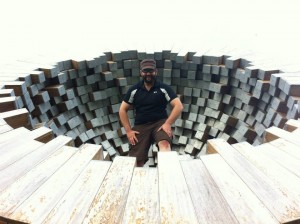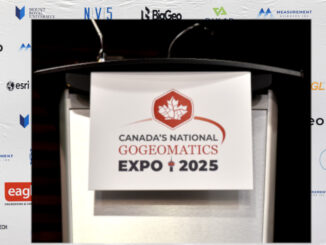
A couple weeks ago, I decided that I wanted to take one of the Esri Technical Certification Exams to improve my resume and my career. I find, like I imagine many other young GIS professionals in the Canadian GIS Marketplace, the plethora of geomatics qualifications, certificates and exams to be an outright jumble. To untangle one part of this, I am writing a three-part series featured in GoGeomatics magazine and newsletter on one of the the Esri technical certifications. In this, the first article, I’ll talk a little bit about my background, why I will take an Esri Technical Certification Exam, and how I registered for it. In the second article, I’ll explain the options for studying in order to attain the Esri technical qualification as well as my own progress. Finally, in the third article, I’ll conclude with the testing process, and my final thoughts on the entire process.
Like many recent graduates over the past five years, I’ve faced challenges making it to the interview stage for GIS jobs. I graduated from the University of Ottawa with a B.Sc. with majors in Physics and Geomatics. Since then, I’ve held three different short-term jobs that held me, but weren’t close to the spatial analytics or problem solving that I desired when I carried out my undergrad. There are many reasons for this, but the biggest culprit is the job market: It’s thin gruel. There are a lot more GIS-users than jobs available, and the education system continues to churn out more graduates from both full-university programs, as well as post-graduate certificates. This is especially the case in large cities in Central Canada. In Western Canada, where the resource boom once held promise for many recent graduates the market has turned upside down. The available work has diminished alongside the global resources boom, and the supply once again exceeds demand even in Alberta.
When I do get an interview, they usually happen with a recruiter or an HR agent who has little knowledge of GIS or geoscience as a whole. Often, I hear the question “from a scale of 1 to 10, how would you rate your skills with ArcGIS”, or a comparable suite. For me, this is tricky to answer. While I’ve always excelled with packages such as ArcGIS in the academic world on my own or compared with my peers, I quickly learned how little I knew when I went into industry. Since then I have improved a great deal, but as I usually work alone, I lack a baseline: I don’t know what constitutes a five.
Since I started thinking about this, I looked into various qualifications and post-nominal titles to add to my college diploma and B.Sc. The GISP appears to be the most popular, and there are also qualifications for ASPRS, CIG and other organizations. But all these require a fair amount of time and I’ve heard increasing amounts of noise from former holders (and current) of these qualifications that call into question the value of these certifications. GIS isn’t alone either: A similar debate is brewing in the graphic design industry over the professional value of the RGD in Ontario. Over the next couple of years, I predict that such debates will only grow. So while I wait and observe what occurs with these other certifications, I’ve chosen to try to pick up the Esri Desktop Associate for ArcGIS 10.3.
Further Explanation of the Esri Technical Certification Exams
Esri hasn’t been the first monolithic software company to sell proficiency certification for their platforms. Microsoft and Adobe have both created and incremented similar benchmarks for everything from using their software to the development of add-on’s designed to prove competency in their software platforms. Like the other two companies, Esri carries out their examination through Pearson, a publishing and education provider, at private colleges and polytechnic institutes across North America.
The Esri Technical Certification exams follow a wide range of topics. If you want something that shows your competence in development, there are tests for web and desktop developer. If you are a power-user and can manage enterprise-level data – or build it from scratch, there’s a test for you! However, as someone who is competent with basic analysis, scripting and visualization on the desktop, the ArcGIS Desktop Associate exam is what I need. Because Esri technology is constantly changing, they try to update their exams every time a certain threshold of content has changed between versions. I’ve decided for this round of testing that I want to take my chances with the Associate Exam for version 10.3, so that employers will be able to recognize it for longer. The price point appears reasonable: $225 USD is a reasonable amount for a qualification from a company who usually prices out their in-house courses at costs well beyond my threshold of $1,000 USD. Not only does the price-point of this exam seem reasonable, so does the convenience for signing up for one of these exams and taking it.
Pearson-Vue, the agency responsible for carrying out the testing, houses their testing facilities in all manner of private colleges worldwide. These are small colleges as well as miniature second-story downtown classroom setups that specialize in a handful of classes. The testing isn’t just for the Esri examination either, but for all tests carried out under the Pearson brand. This scale achieved through specialization is convenient for me. For example, I was able to find examinations for the next day in Hinton (Ab), all across Toronto and SW Ontario and other locations in addition to appointment availability within a week for several other locations. The ease and expediency of the testing makes it seem like my $225 USD is good value for money, if I have this much flexibility over timing. It gives an air of a well-oiled machine.
My own registration process
The registration process is straightforward. First, you have to create a free account with Pearson Vue (you can start here!) and isn’t much harder than creating a new email address, or registering a domain. The process requires one business day to complete. Once you’ve registered with Pearson Vue, you can begin selecting an exam. In all, the process has four stages: selecting the exam, selecting the location, selecting the date and time, then closing with your standard store checkout.
Unfortunately, the cost is $225 USD. This is not good news in Canada, as our currency has fallen in value compared to the American dollar. For myself, committing to a date is the trickiest part given that my work forces me to work all hours, away from most towns and cities. But I have a date selected for my next return from the field, and I plan to be ready to slay this beast once I return.
Concluding thoughts
One thing that I’ve always been taught by employers, peers and mentors is the importance of being able to outperform your competition. Traditionally, GIS Analysts could do this either through traditional qualifications and designations, as well as through portfolios. While I already have a decent portfolio, I haven’t obtained any qualifications or certifications since leaving university. Having this qualification seems to give me not just another feather in my cap, but also some inoculation against skill fade: Here is proof that I was proficient in this software suite. It shouldn’t be a stretch if I had to become proficient in a later release, or a similar product – or at least my logic goes. Now that I’m dedicated to this, I best sit down and prepare some notes as I brush up on many things in ArcGIS, and possibly learn a few new things too!





Be the first to comment